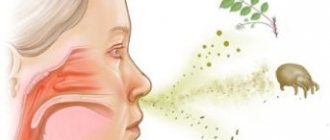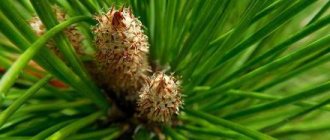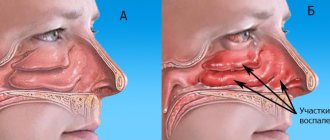How do boogers form in the nose?
Where do boogers come from? The lining of the nasal cavity is covered with ciliated epithelium. In order to moisturize the inner surface of the nose, epithelial cells synthesize a secretion.
Under the influence of negative exogenous and endogenous factors, the secretory function of the epithelium is disrupted, the synthesized mucus dries out, and dry crusts appear in the nasal passages. Dried secretions cause discomfort and itching in the nasal cavity, so a person has a desire to pull the crusts out of the nose. Doctors call the habit of picking snot out of the nasal passages rhinotillexomania.
Dried snot consists of dust particles, dead epithelial cells, mucoprotein, salts, and nucleic acids. Mucoprotein is a protein that is the basis of nasal mucus. Its concentration determines the degree of viscosity of the secretion. The more protein, the faster the mucus dries.
The main functions of nasal secretion are to protect the inner lining of the nasal cavity from harmful factors, cleanse the nasal passages of foreign particles, and soften the mucous membrane.
When the inhaled air contains dust, soot, infectious agents, and irritants, mucus production increases, which leads to excessive formation of boogers.
Drying of nasal mucus is observed when exposed to the following factors:
- too dry air in the home,
- damage to the mucous surface of the nasal cavity,
- dehydration of the body,
- dysfunction of the nasal ciliated epithelium.
If boogers form very often, then serious pathologies of the mucous membranes of the nasal cavity can be suspected. If there is extensive crust formation in the nose, you should contact an otolaryngologist to establish a diagnosis and receive therapeutic recommendations.
Exogenous and endogenous causes
Conventionally, the causes of thickening of nasal secretions can be divided into external and internal. In most cases, crusts in the nose appear due to the adverse effects of exogenous factors. Detection and elimination of the key causes of disruption of the secretory function of the glands in the nasopharynx makes it possible to prevent the formation of dry crusts on the inner surface of the nasal passages.
Air dustiness
Most often, the problem associated with the formation of crusts in the nasal cavity occurs in people working in hazardous industries. Particles of lumber and molecules of paints and varnishes play the role of thickeners, affecting the consistency of nasal secretions. Constant work without a respirator will sooner or later cause the mucus in the nasopharynx to dry out and, as a result, dry crusts to form.
It should be understood that nasal secretions have pronounced antiseptic properties, so their thickening leads to a decrease in local immunity in the respiratory tract. As a result, this can provoke the proliferation of opportunistic fungi and bacteria in the nasopharynx, which will cause the development of rhinorrhea, nasopharyngitis, bacterial rhinitis, etc.
Why do children put boogers in their mouths?
The main task of a child is to explore the world. Children explore surrounding objects and phenomena mainly through touch and taste. That's why small children always reach out to something with their hands and try to put something in their mouth.
Of particular interest to children is their own body. A child who first pulls a goat out of his nose immediately tastes it. It must be said that if the baby likes the taste of a booger, then picking his nose with his finger can become a habitual thing.
Eating boogers from the nose is a bad habit that a child must be weaned from . Kids get so used to picking their noses that they continue to do it even during a cold, accompanied by the formation of thick green snot.
But green snot is saturated with pathogenic bacterial microflora; eating it worsens the child’s health and delays the onset of recovery by several days.
Where does snot come from?
Each human organ performs specific functions. So the nose is responsible for breathing and smell. The inner walls of the nose have a delicate layer of epithelium, which is protected on top by mucus. In addition to olfactory receptors, the nose is also equipped with other endings that are sensitive to various stimuli. So, any dust that gets into the nose or a dried clot of mucus can excite the receptors.
The flapper is just a dried mucous substance that is produced by the nose specifically to moisturize and clean it. Essentially, it is the same as tears or drool.
What happens if you have boogers from your nose?
Is it healthy to eat dry snot? Or is it harmful? Medical experts have different opinions on this matter. Some doctors claim that there is nothing harmful in dried nasal secretions, and picking your nose is a natural way to cleanse the nasal passages.
Other experts say that eating snot spreads infection throughout the body. If a person with a weak immune system eats snot, he gets an infection in the digestive tract.
The above situation happens extremely rarely. And not a single person died from rhinotillexomania. However, one should not exclude a connection between the habit of eating nasal secretions and the appearance of infectious pathologies of the stomach, intestines, liver, kidneys and other organs of the digestive system.
You also need to take into account that worm eggs are sometimes present in dry nasal secretions. Therefore, a person who eats boogers runs the risk of contracting helminthiasis.
The danger of habit
During an exacerbation of colds, the discharge becomes liquid. Doctors warn that eating snot is strictly prohibited. It's all about the infection in them. Especially if the slippery contents of the sinuses take on a greenish tint. Bacteria, when ingested, provoke even greater complications for the body. Of course, no one died from this, but increasing the duration of the disease clearly does not improve immunity. Especially if it could have been avoided.
Adults are also susceptible to this habit. Naturally, loved ones have no idea about this. Rarely did anyone notice a girl or woman behind this unaesthetic process. One way or another, snot gets into the body, if only because it flows down the nasopharynx.
To minimize the danger when a runny nose occurs, you should immediately start dripping vasoconstrictor drugs into your nose. And regularly empty the contents of the nose using a slightly salted or sea solution.
How to stop a child from eating boogers?
It is unpleasant for parents to watch a child take roefish out of his nose and eat it. But if the baby does not yet know how to speak, then it is useless to explain anything to him. Parents with a child under 3 years old should be given only one piece of advice: they need to provide their child with entertaining games that develop fine motor skills .
A child who sculpts from plasticine, plays with construction sets, or paints with finger paints does not get bored, so he is not distracted by picking his nose.
You can already talk to a three-year-old child about the fact that eating goats is bad. The child needs to be explained that:
- picking your nose in front of strangers is unsightly,
- They laugh at children eating boogers,
- a child chewing snot is called names and insulted,
- There is a lot of dirt and germs in the kozyulki.
Symptoms
Why do bloody boogers appear in the nose? The main symptom of blood in the nose is dry nasal mucosa. The blood bakes into a crust, there is an unpleasant smell and the nose is completely blocked. The person cannot breathe or smell normally.
Before the blood boogers collect, the inferior turbinate of the nose becomes deformed. The cavity of the nasal passages expands very much. When examining a person with this disease, the doctor performs a rhinoscopy. It becomes clearly visible that the atrophy of the walls of the passages goes further into the nasopharynx. The crust covering the mucous membrane has a brown or green tint. A dried crust envelops the entire nose from the inside.
Preventing the formation of boogers in the nose
If the child does not have dry sniffles, then there will be no nose picking either. To prevent the formation of boogers in the nasal cavity, you need to:
- normalize the temperature and humidity in the home,
- ventilate living spaces several times a day,
- If your home is too dry, use a humidifier,
- clean the children's bedroom from dirt and dust,
- do cleaning regularly,
- walk with your child outside for several hours every day,
- in dry weather, use moisturizing drops and sprays to irrigate the baby’s nose,
- in case of respiratory diseases, do not get carried away with the use of vasoconstrictor drops,
- if necessary, correct the deviated nasal septum.
Parents need to be attentive to their child, carefully monitor his well-being, offer him exciting games and activities, and walks in the fresh air. In most cases, with a competent approach to the problem, parents manage to rid their child of rhinotillexomania.
As for adults, whether to pick their nose or not is a personal matter for everyone.
It must be remembered that nose picking is a natural need to free the nasal passages from secretions, but eating snot in adulthood is often evidence of mental pathology.
Treatment
Boogers in the nose are not a pathology. Getting rid of them at the initial stage is not difficult. In order not to start the process before the crusts penetrate from the nose into the pharynx, you need to know about the basic methods of treatment.
Drug therapy
To get rid of crusts in the nose, experts recommend using special ointments and oils that soften the mucous membrane and allow boogers to freely leave the nasal cavity. Rinse your nose with boiled water, infusion or decoction of medicinal herbs.
- You can lubricate the nasal passages with baby cream, Rescuer, Fleming, and Malavit ointments.
- Using a seawater-based spray - “Aqualor”, “Aquamaris”, “Otrivin”, “Humer”, “Physiomer”, “Quix”.
- In severe cases, aloe injections and irrigation of the mucous membrane with Nicotinic Acid are prescribed.
- A special nasal aspirator designed for infants will help remove boogers from a baby's nose.
- For sinusitis accompanied by the appearance of green crusts, antibiotic therapy is carried out.
- Vasomotor rhinitis with a large accumulation of transparent or white boogers is treated with sedatives, herbal infusions, and a contrast shower.
If the problem remains and the “goats” continue to “attack”, you need to contact an ENT doctor.
Physiotherapy
- Photodynamic therapy is a method of exposing the mucous membrane to light waves, normalizing the functions of the nasal membranes and stimulating lymph flow.
- Ion therapy is the introduction into the body of medicinal substances using direct current that improve the condition of the tissue structures of the nose. This is a kind of electrophoresis of medicinal substances using stationary electrodes.
- UHF therapy has a lasting therapeutic effect.
Therapy
During the study, when a pathology is identified, it is necessary to get rid of the pathogen, and later the symptom - the bloody goat - is removed. If no other diseases are found in the body, but there is always a bloody crust in the nose, the doctor prescribes:
- organotherapy – to restore the functioning of the mucous membrane;
- phytodynamic therapy. This course of treatment is prescribed after the nasal mucosa has been restored. This is the consolidation of organotherapy;
- iontophoresis – restoration of tissue functionality;
- Irrigation and rinsing of the nose using products with mineral supplements.
If there are no pathologies, it is necessary to constantly humidify the air in the room where a person spends more time. To restore the mucous membrane, you can use antiseptic ointments.
Using traditional medicine to get rid of boogers
Some people, not wanting to resort to special drugs, use traditional medicine. Sunflower oil is extremely popular, as well as olive, avocado and sea buckthorn extracts. They help soften the nasal mucosa and facilitate the removal of crusts from the respiratory cavity. The listed components can be instilled into the nose, or you can moisten the turundas with them, which then need to be placed in the nostrils.
In the fight against unpleasant formations, you can use boiled potatoes. First, you need to cool it a little so as not to burn your facial skin. After which the potatoes should be applied to the nose until they cool completely.
Rinsing procedures with decoctions of medicinal herbs and ordinary boiled water are also effective.











